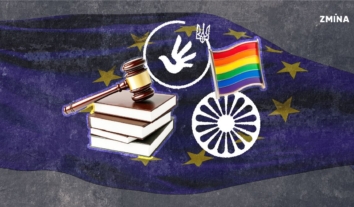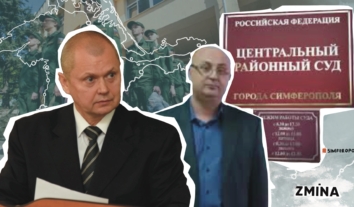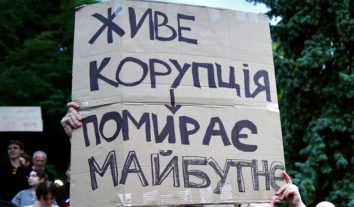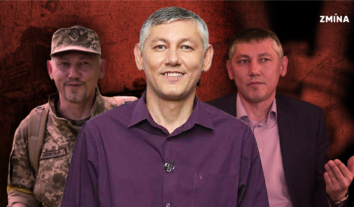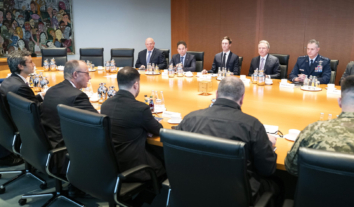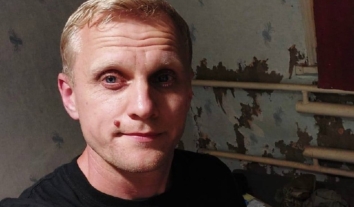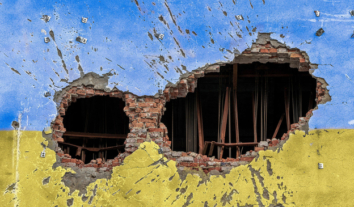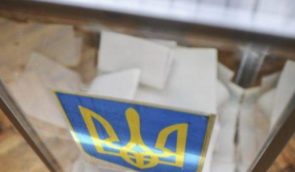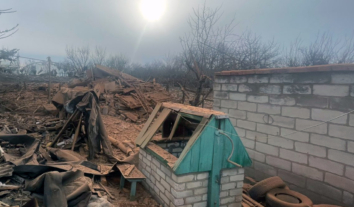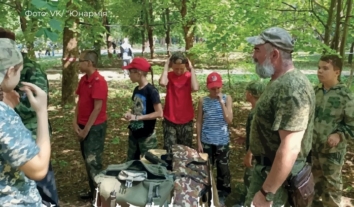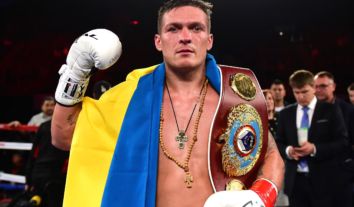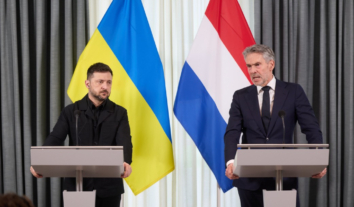Operation Blockbuster: why Russians shoot staged videos with detained Ukrainians
Russian propaganda media and law enforcement agencies publish almost daily reports of Ukrainians being detained in the occupied territories or in Russia. Most of them are suspected of terrorist activities or extremism, as well as of storing, transferring, and manufacturing explosives or weapons or of espionage and treason.
Russia is doing everything possible to conceal detained civilians for as long as possible. Thus, residents of the occupied Ukrainian territories can be held without charge for months or even years.
At the same time, the number of court cases against Ukrainian citizens is growing in Russia. Entrepreneurs, teachers, coaches, carpenters, and journalists are sentenced to 10 to 30 years in prison in Russian courts.
Detained Ukrainian civilians in Russia are also used by Russian propagandists and featured in short confession videos or lengthy TV segments. All such videos end in much the same way: intimidated and often beaten people warn others about the dangers of cooperating with Ukraine.
ZMINA explored how Russian security forces and courts turn civilian Ukrainians into “terrorists” and why propagandists publish videos of their detentions and confessions.
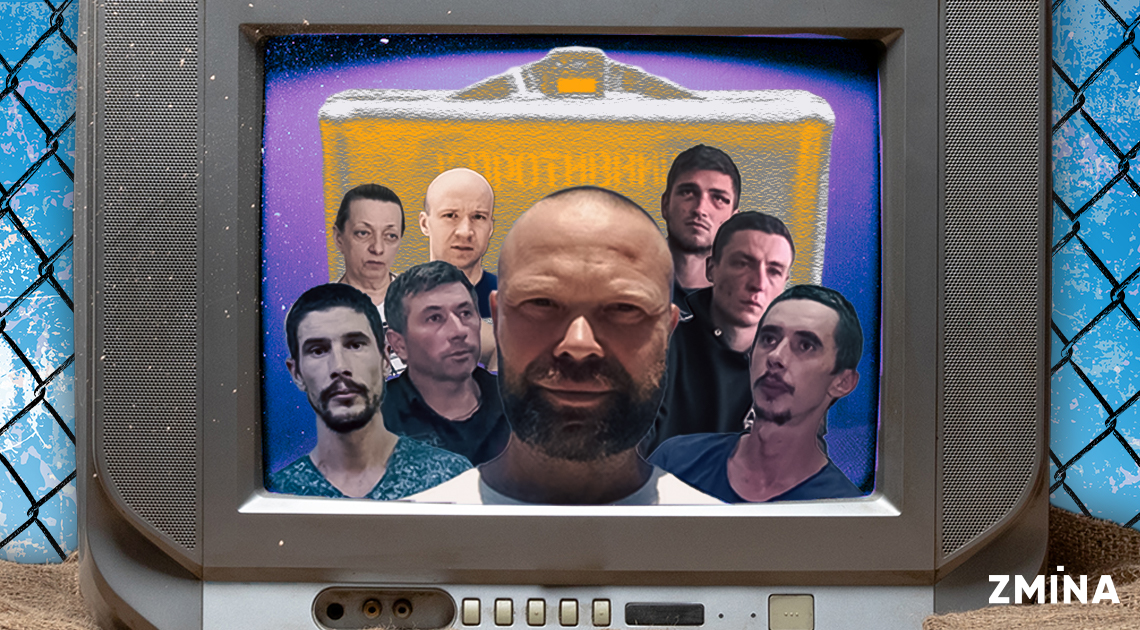
Confession under duress
On September 29, 2022, an explosion occurred in the occupied Melitopol in the Zaporizhzhia region. Representatives of the occupation administration immediately called it a terrorist attack organized by the Ukrainian special services. Allegedly, unknown saboteurs attached homemade explosives to a tree near the school where the illegal so-called “referendum” was held.
On October 13, Russian security forces reported on the detention of the “terrorists.” Allegedly, the explosion was prepared by two Melitopol residents, Artur Nesterenko and Roman Zarubayev.
On the same day, propaganda media published a video of the detainees, allegedly operational footage handed over to them by the security forces. The video clearly shows wounds, bruises, and scratches on the men’s hands and faces. The video is heavily edited. In some places, the detainees’ answers consist of several cut-out phrases.
Nesterenko has significant bleeding in his left eye and scratches on his face and neck. In the video, he says that shortly before his detention, the so-called Ukrainian curators ordered the men to take another package of explosives. Allegedly, according to the plan, the Melitopol men were to hide the package at their place overnight and move it to the specified location the next day. However, according to Nesterenko, around midnight, the explosives went off in the apartment where they were hiding. The men were allegedly in the next room at the time, so they received only minor injuries and concussions.
According to Russia’s Federal Security Service (FSB), the Ukrainian special services allegedly wanted to get rid of their “ineffective agents” in this way.
In support of this, Zarubayev said in the video that he had previously received only one order from the Ukrainian side. Namely, to place explosives under the school’s windows.
“Then they wrote to me that the explosion was very bad: no one was hurt, even the windows were not broken,” Zarubayev says in the video. After these words, there is an editing glue: “I knew there were children there during the day,” the man allegedly adds.
The video shows scratches on Zarubayev’s face and hands, which are covered with brilliant green. The man also has a hematoma over his eye, just like Nesterenko.
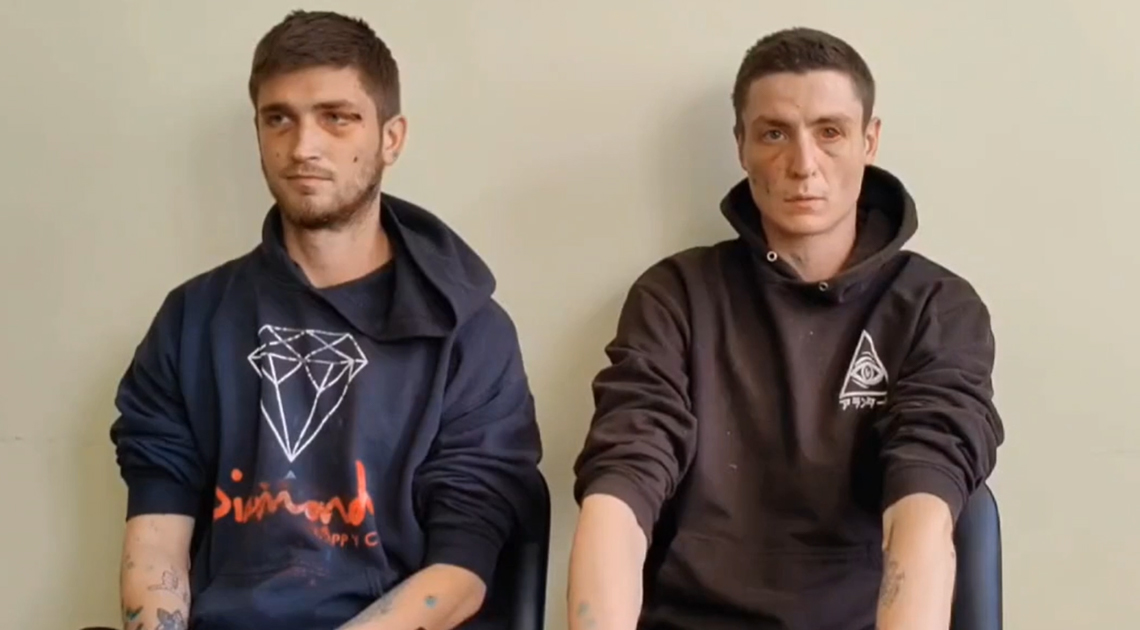 Roman Zarubayev, right, and Artur Nesterenko, left
Roman Zarubayev, right, and Artur Nesterenko, leftHuman rights defenders note that Russian security forces use coercion and threats to persuade detainees to appear in such propaganda videos. Those released from Russian captivity told how they were given a sheet of paper with a pre-written text in their custody and, threatened with execution, were forced to read it for the record. They were often forced to voice accusations against the Ukrainian authorities of crimes against civilians and praise the Russian army or even confess to serious crimes.
For example, ZMINA documenters recorded at least seven cases where Russians forced civilians to appear in propaganda videos. At the same time, they were held in an improvised torture chamber in a school building in the village of Bilyayivka, Kherson region. For refusing to read the text on camera, the Russian military threatened them with long prison terms and murder: “Either you read the text to us on camera, or you go to the pit.”
Threats, humiliation, and inhumane conditions of detention persuaded Kherson educator Olena Naumova to appear in propaganda videos. She was kidnapped from her home in the summer of 2022 and accused of extremism because of her video on TikTok: the woman had been actively maintaining her page before the full-scale invasion, and after the occupation, she began to talk about life in the occupied city. She was also accused of financing the Ukrainian army.
The woman was ordered to apologize to the Russians and the Russian military and to remind other Kherson residents that anyone who expresses a pro-Ukrainian position like Naumova could end up in prison.
The men detained in Melitopol also “warned” against cooperation with the Ukrainian side in the video.
The voiceover asks the beaten men, “What would you like to say to those who want to follow your path in the future?” The question refers to cooperation with Ukraine’s special services.
“It’s not worth it,” Zarubayev replies.
“They don’t value the people who are with them. For them, people are expendable,” Nesterenko adds.
The man tells how his Ukrainian “curators” allegedly threatened him with execution if he failed to complete another task.
“They said: “You have a pregnant wife. Think about it,” Nesterenko seems to add in the video.
Moreover, the man goes on to repeat the theses typical of Russian propaganda: that Ukrainian special services threatened to shoot anyone who disagreed with them immediately after the city was liberated from Russian forces.
Almost a year after the men were detained, in early September 2023, their case was transferred to the Southern District Military Court in Rostov-on-Don. The next hearing in the trial was scheduled for May 17.
Nesterenko and Zarubayev are charged with several criminal articles: illegal storage and transportation of explosive devices or their parts, manufacturing of explosives, a terrorist act, and, of course, participation in a terrorist organization. In addition, Nesterenko is also charged with illegal possession or carrying of weapons.
The case file of the Melitopol residents is being considered by a panel of three judges headed by Denis Galkin. Interestingly, this judge’s father, Aleksandr Galkin, was the commander of the Southern Military District until 2016. According to the Security Service of Ukraine (SBU), he was directly involved in the seizure of the territories of Donetsk, Luhansk regions, and Crimea in 2014.
It is not the first time the judge has considered cases of Ukrainians. For example, on December 7, 2023, a panel of judges chaired by Denis Galkin sentenced Ukrainian Dmytro Lisovets to 16 years in prison, who was detained when he tried to leave occupied Mariupol. The man was found guilty of alleged extremism, participation in a banned organization, and “undergoing training to carry out terrorist activities.” The man received the latter charge because of his service in the Armed Forces of Ukraine before the full-scale invasion.
Detention by scenario
Russia began trying so-called “terrorists” in the occupied Ukrainian territories in 2014.
Two months after the seizure of Crimea, in early May 2014, filmmaker Oleg Sentsov, student Oleksandr Kol’chenko, photographer Gennadiy Afanasyev, and scholar Oleksiy Cherniy were detained in Simferopol. The men were accused of preparing terrorist attacks on the peninsula.
As the prisoners themselves later said, the Russians tortured them to extract confessions to crimes they did not commit. Eventually, a court in Crimea handed down guilty verdicts against all of them. Sentsov was sentenced to 20 years in prison, including for creating a terrorist organization. Kol’chenko was sentenced to 10 years in a strict regime colony, while Afanasyev and Cherniy were sentenced to 7 years in prison.
Due to prisoners’ exchanges between Ukraine and Russia, almost all defendants were released before the end of these terms. Thus, Afanasyev returned home in 2016, Sentsov and Kol’chenko were exchanged in 2019, and only the scientist Cherniy served his entire sentence in Russia. Over seven years, he was transferred several times to different colonies, including Moscow, Rostov-on-Don, and Magadan. He returned to Ukraine in 2021.
During the eight years of occupation of part of Ukraine, Russia has held few such trials. Mostly, these were large show trials intended to intimidate the population of the occupied territories and show how scary Ukrainians can be.
At the same time, since the beginning of the full-scale invasion, the scale of detentions has increased dramatically. Experts from the Organization for Security and Co-operation in Europe (OSCE), in particular, note that since the end of February 2022, Russia has illegally taken thousands of Ukrainian civilians hostage. A large number of people have gone missing.
After the outbreak of the full-scale war, the number of terrorism-related trials began to increase. In particular, in 2023, 111 cases of terrorist activity were sent to Russian courts. For comparison, in 2022, there were 39 such cases in Russia, and even fewer before that. In the trials opened in 2023, 163 people were accused of terrorism. According to the Russian media outlet Proekt, almost every fifth of them is a Ukrainian.
For example, on August 28, 2023, a Russian propaganda channel aired a report on how the SBU allegedly managed to prevent a terrorist attack in Kyrylivka, Zaporizhzhia region and detained a “cell of the Ukrainian special services.”
The report contains supposedly operational footage, but it also looks like a well-thought-out but relatively cheap action movie.
Here is one of the so-called terrorists walking along a road somewhere allegedly outside of Kyrylivka. He has only a backpack with him. His task is to pick up explosives hidden under a power line pole in the middle of an open field not far from residential buildings.
However, the man does not know his plans have been exposed. Security forces film him from a drone and an ambush on the ground. The viewers are immediately shown the FSB officers themselves as if they were watching the “preparation for the crime” in real time. The security forces have two monitors in their office: one shows drone video, and the other shows footage from a covert operation. However, the videos are not synchronized – while in one video, the man is just approaching the pole, in the other, he has already reached it. Moreover, there are no marks on the screens of the security forces that could indicate a live broadcast. It suggests that the security forces are watching pre-recorded footage.
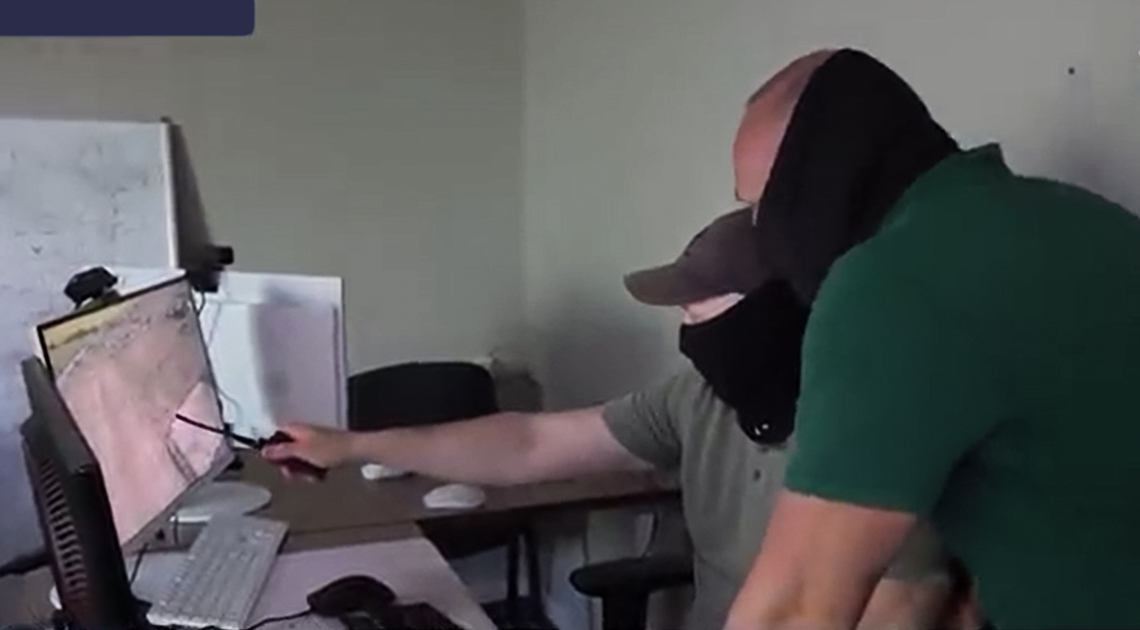 Screenshot from the propaganda video
Screenshot from the propaganda videoThe propagandists also showed the moment of detention of an imaginary “terrorist.” He was allegedly caught on the street in the private sector of Kyrylivka. This event was also filmed from two angles.
The man in the video is Serhiy Chumachenko. His friends say he is from Zaporizhzhia but has lived in Kyrylivka for four years.
The man was abducted on August 11, 2023, more than two weeks before the propagandists published their report. According to Chumachenko’s acquaintances, he was not detained in the way depicted in the video but was abducted from a sports field near his home.
In the propaganda video, the security forces noted that the man allegedly did not work alone – it was a “network of saboteurs.” Chumachenko’s accomplices were allegedly three other residents of Kyrylivka – brothers Petro and Oleksiy Popadeikin and Serhiy Dzyamka.
The Russians assigned a separate role to each of the detainees: Serhiy Dzyamka allegedly found out where the potential victims lived and what kind of cars they drove, Petro was responsible for the caches, and Oleksiy transported the explosives. He allegedly left the package near the pole, from where Chumachenko later retrieved it. Russian security forces named the latter as the head of the terrorist group.
However, the Russian media did not specify what exactly Chumachenko was doing other than taking the explosives. Thus, the author of the TV story first says that the security forces detained Chumachenko a few days after he took the package of explosives.
At that time, the man allegedly called his SBU supervisor and assembled an explosive device according to his instructions.
“He did everything according to the instructions and then put the explosives in the car,” the propagandist says about Chumachenko in a tearful voice.
The video also showed the alleged confession of the detainee himself.
“I planted a bomb.” “I wanted to blow it up,” the man says in two consecutive cuts.
However, a little later, the author of the TV story shows what the security forces allegedly found in the man’s car: a phone, a remote control for remote activation of explosives, and a MON-90 anti-personnel mine.
According to the security forces, the so-called “terrorists” wanted to put this mine in an old Tavria car and place it on the main street of the city. The plan was to detonate the mine in the morning so that there would be more people on the street and thus more victims, the report emphasizes.
In the video, Chumachenko, like civilians detained in other cases and regions, also talks about the pressure on him by the Ukrainian special services. Allegedly, at first, the man refused to follow the instructions of the Ukrainian special services but received threats against his son, who then lived in Zaporizhzhia.
“They sent me a video of my son and began to intimidate me that they might do something to him,” the man tells the Russian propagandist.
Moreover, the author of the story goes on to say that all the detainees allegedly accused the SBU of collaborating with criminal authorities.
“I was afraid to say no, because his people [the curator’s] could arrange anything,” Serhiy Dzyamka seems to add.
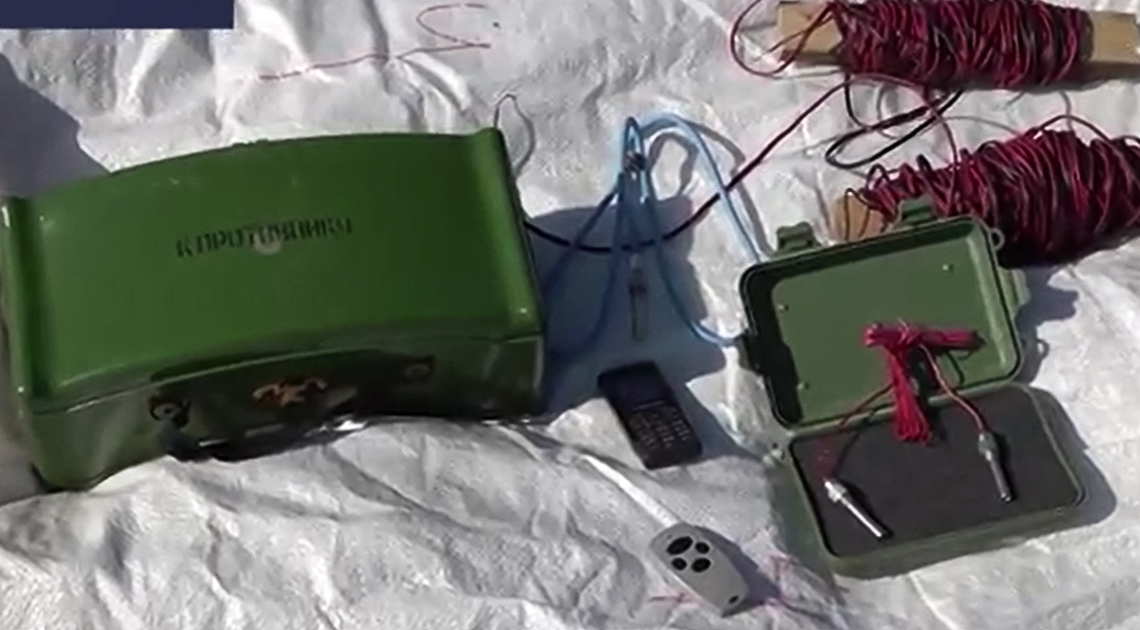 Screenshot from the propaganda video
Screenshot from the propaganda videoThrough such propaganda videos, the Russians primarily create a frightening image of Ukraine, its special services, and the population in general, said Yevhenia Kapalkina, a lawyer at the Ukrainian Legal Advisory Group ULAG.
According to her, the videos themselves, even if they contain people’s confessions of crimes, have no significance in court and, therefore, are created primarily to intimidate and control the Ukrainian population of the occupied territories and Russian citizens.
“Russia is forming a negative opinion in society that Ukraine is allegedly constantly sending terrorists who commit crimes against Russia, its citizens, and residents of the occupied territory. Accordingly, Russia is trying to save everyone,” Kapalkina said.
The report repeatedly emphasized that the security forces had been monitoring the suspected terrorists’ every move since their contact with Ukrainian handlers. The Russians allegedly tapped the men’s calls, read their correspondence, and even had access to the detainees’ social media accounts.
At the same time, Russia has not released any information about these men for over six months. We still do not know where they are being held, the duration of their arrest, or the state of the case in general.
The Prosecutor General’s Office of the Russian Federation announced in March 2024 that it had sent Oleksiy Popadeikin’s case to the Southern Military District Court in Rostov-on-Don.
The man was officially accused of allegedly receiving training for terrorist activities, being a member of a terrorist group, as well as illegally transporting explosives and making explosive devices himself. In addition, Popadeikin is accused of preparing for a terrorist attack that could have led to someone’s death.
There is currently no information about the other detainees.
Zelenskyy’s sex spy
Although such videos do not carry weight in courts and should not be played during trials in general, lawyer Yevhenia Kapalkina says they sometimes directly affect verdicts. It is particularly true when a jury considers the case of so-called terrorists or extremists.
For example, in 2015, the Investigative Committee of the Russian Federation brought the case of Mykola Karpiuk and Stanislav Klykh to court. The men were accused of participating in the First Chechen War. Allegedly, in 1994-1995, the detainees fought against the Russian army in Grozny.
A jury in the Chechnya capital tried the Ukrainians.
“In such cases, the guilt of the defendants is determined solely by the jury: without proving guilt, without research and analysis of evidence. And in such situations, there is a high risk that accusatory rhetoric against the detainees will influence the jurors and their decisions,” Kapalkina adds.
The lawyer also draws attention to the fact that videos with detainees’ confessions, investigative experiments, or alleged evidence of crimes are usually published not on the websites of law enforcement agencies but in Russian state media and other propaganda resources. It, in particular, allows them to go beyond the procedural code, not to observe the presumption of innocence, and to cover the situation precisely as the Russian side needs.
For example, on September 24, 2023, the Russian TV channel NTV aired another episode of the New Russian Sensations program called Zelenskyy’s Sex Spy. In the episode, the propagandists told the stunning story of a Ukrainian border guard who had allegedly been hiding in the occupation for several months and was preparing terrorist attacks in the Donetsk region.
The man in question is Lieutenant Colonel Denys Storozhuk of Ukraine’s State Border Guard Service. He commanded a border guard unit in Mariupol when the full-scale invasion began and eventually ended up at Azovstal.
According to his sister, Storozhuk did not agree to surrender to Russian captivity in May 2022. Instead, he hid in one of the sewer maintenance holes on the plant’s territory for almost three weeks. The soldier’s sister also said that he had injuries to his legs, so he could not get to the territory controlled by Ukraine.
The Ukrainian lieutenant colonel was forced to enter the occupied territories. There, he found shelter and stayed from May 2022 to April 2023.
The Russians also discussed Azovstal and the maintenance hole in the TV program. They even brought Storozhuk to record part of the interview against the backdrop of the destroyed plant. However, the propagandists ran out of facts.
According to Russian TV reporters, Storozhuk escaped from the plant and hid in Mariupol for some time. He allegedly found a phone and called an old friend who lived under occupation.
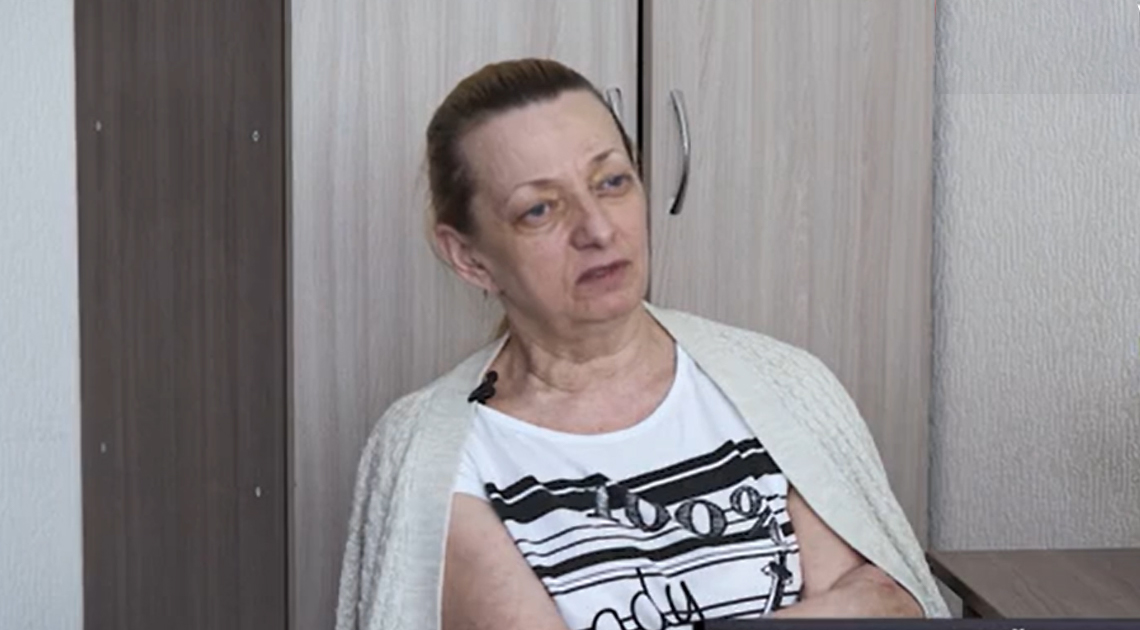 Valentyna Zayarna. Screenshot from the propaganda program
Valentyna Zayarna. Screenshot from the propaganda programValentyna Zayarna, a 63-year-old resident of Amvrosiivka, a village in the Donetsk region 2-hour drive from Mariupol, at the time, allegedly agreed to take Storozhuk from Mariupol right away.
The woman said she met the Ukrainian soldier at the Pyshchevyk checkpoint in 2020.
To intrigue and excite the audience, the authors of the issue resorted to semi-mysticism. For example, a woman told the camera how she lost her baby in the late 80s in the last months of pregnancy. According to her, the baby would be a boy, and she even came up with a name for him – Dmytro. This is how Storozhuk allegedly introduced himself to Zayarna when they met. In addition, he reportedly told the woman that he was born in 1988, the year her son was supposed to be born.
“Something clicked in my head: God gave me back my son. The boy I didn’t get in my time,” the tired-looking woman reflects in the program.
According to the propagandists, the story is more straightforward: Storozhuk allegedly knew everything about Zayarna before he came to meet her. However, why did the Border Guard Service’s lieutenant colonel need such detailed information about a woman from the occupation, and why did he meet her at all?
According to the authors of the issue, the Ukrainian border guard and the woman from Amvrosiivka periodically communicated and even saw each other after they met.
In particular, the woman recounted how Storozhuk once came to her home to congratulate her son on his first job. She allegedly prepared dinner, after which they talked to each other for a long time. However, the propagandists do not specify how exactly the Ukrainian lieutenant colonel Storozhuk from Mariupol could have come to Amvrosiivka, which has been occupied since 2014.
In the program, the woman told another almost fantastic story. Her son allegedly needed a certificate of knowledge of the Ukrainian language. Zayarna allegedly turned to Storozhuk for help, and he forged an imaginary document for her. For this, the propagandists emphasize, the woman offered the border guard a drink of champagne.
During the almost 50-minute pseudo-documentary TV show, the propagandists did their best to emphasize that Storozhuk and Zayarna had an intimate relationship.
“A professional spy easily turned the head of an elderly lady…”, “a sociable woman immediately caught the eye of a smiling officer of the Kyiv regime…”, “tea-coffee-dance,” “light flirting at the table…” – Russian TV reporters repeated such lines every few minutes.
At the same time, neither Storozhuk nor Zayarna says in the video that their relationship is anything closer to friendly. The border guard always calls the woman by her first name and patronymic, and she respectfully addresses him.
Several times throughout the program, the propagandists ask questions: “Is Valentyna Zayarna a victim of a clever sex spy or a conscious accomplice of a terrorist?” They try to find the answer: a cunning Ukrainian spy recruited the woman, hid in her home, and sent her on a “mission” to monitor the local administration. However, Zayarna later became “used material” for the Ukrainian lieutenant colonel. After his arrest, the TV reporters said that Storozhuk began to take care of only himself.
In the woman’s apartment, the security forces allegedly found weapons left by the Ukrainian soldier, as well as his forged documents and even medals. The story of Storozhuk hiding at Azovstal for three weeks with his awards and documents for them seemed unrealistic even to Russian propagandists. Therefore, they hinted that the Ukrainian border guard had hidden his personal belongings in Zayarna’s apartment before the full-scale invasion.
The investigation ultimately decided that Zayarna was assisting Storozhuk in his crimes. She is now charged with terrorism, participation in a terrorist group, and illegal possession of explosive devices.
The Ukrainian lieutenant colonel is accused of a terrorist attack, participation in a terrorist group, facilitating terrorist activities, storage, transfer, sale of explosive devices, and forgery. He is charged with violating eight articles of the Russian Criminal Code.
The case of Storozhuk and Zayarna was transferred to the Southern District Military Court at the end of March this year. One hearing has already occurred, and the second was postponed because the defendants were not brought to court. The next hearing was held on May 15.
Thanks to such videos, Russia not only stigmatizes Ukrainians as terrorists but also publicly justifies its crimes, said Onysiia Syniuk, an analyst at the ZMINA Human Rights Center.
For example, in Russian detention, hostages are forced to tell the camera about the good conditions of detention and the courteous treatment they receive. Prisoners of war are beaten and forced to confess to war crimes against civilians that Russia itself committed.
To distort the truth and whitewash their reputation, propagandists do not hesitate to embellish the stories of detainees with incredible criminal details, distort their words with editing glues, and substitute video footage.
For example, in an NTV program about Storozhuk, propagandists used footage shot by Mstyslav Chernov in Mariupol to illustrate how the Ukrainian army allegedly destroyed civilians—a Russian tank fires on a residential building in the actual video published by the Associated Press.
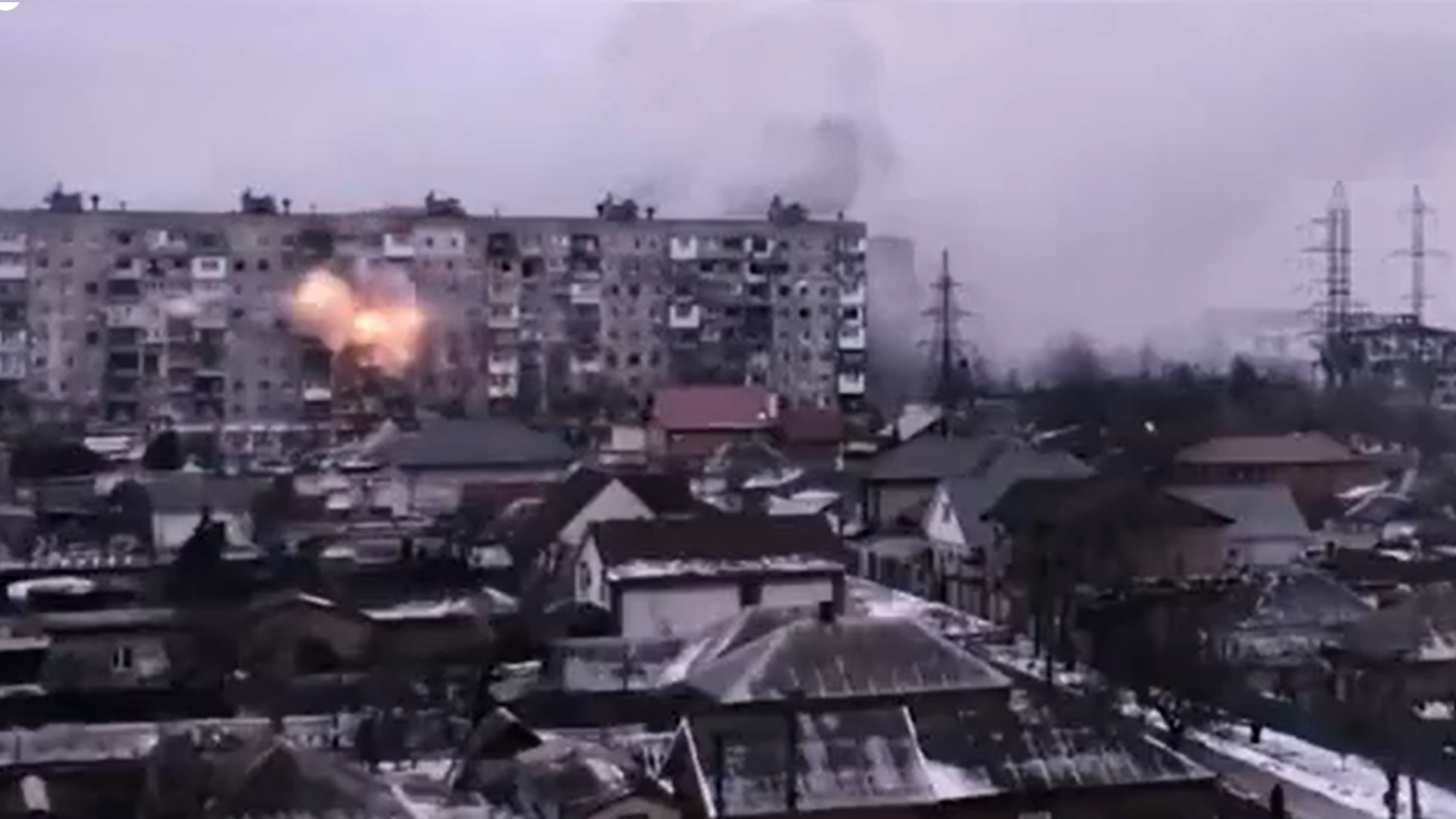 Screenshot from the propaganda program on NTV. The actual footage is from the Oscar-awarded documentary “20 Days in Mariupol” by Mstyslav Chernov
Screenshot from the propaganda program on NTV. The actual footage is from the Oscar-awarded documentary “20 Days in Mariupol” by Mstyslav ChernovIn addition to establishing the image of a terrible enemy and justifying their crimes, such videos have another task: to show the population of the Russian Federation and Ukrainians in the occupied territories how dangerous the world is around them and that only Russia can save them.
Difficult security conditions, the invasion of violent criminals, and the constant threat of terrorist attacks become very convenient excuses for increased repression. Under such conditions, wiretapping, surveillance, and severe restrictions on expression and opinion can be justified as a critical necessity.
“It helps keep people in line,” emphasizes lawyer Yevhenia Kapalkina.
Arbitrary detentions and enforced abductions are elements of the global policy of terrorizing civilians, says Yelyzaveta Sokurenko, head of the war crimes documentation department at ZMINA.
These crimes have signs of a systematic nature and are closely linked to other instruments of pressure and intimidation, such as fabricated cases and illegal detention. Human rights defenders also regularly document massive violations of the right to a fair trial.
“From the testimonies of people illegally detained by the Russian Federation and the data collected, we know what is behind these so-called trials: detention without any legal grounds, within deliberately created and maintained inhumane conditions, constant humiliating treatment, physical and psychological violence, lack of access to medical care and a lawyer, coercion to sign or record self-incriminating statements and other gross violations of human rights and international humanitarian law,” emphasizes Sokurenko.
In its recent report, the independent OSCE Mission emphasized that arbitrary detentions of civilians in the occupied territories of Ukraine and Russia are deliberate, widespread, and consistent. In addition, the Mission concluded that there are reasonable grounds to believe that such violations by Russia can be qualified as a war crime and a crime against humanity.

